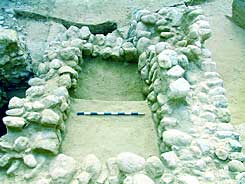In Be'er Sheva, buildings were uncovered from a city that was located there in the eighth century BC, during the Kingdom of Judah. Is this the biblical Beer Sheva?
Ran Shapira

A military fuel base was built near the Bedouin market in Be'er Sheva in the fifties of the last century. Pottery and figurines from the Iron Age, when the Kingdom of Judah ruled the region, were found in the dirt taken out of pits dug to bury the fuel tanks. Most of the finds - figurines of the Canaanite goddess Ashtoreth, pottery candles and storage jars - have been attributed to the eighth century BC, the reign of King Hezekiah.
But the popular opinion then and today is that the biblical Beer Sheva was located about seven kilometers away, in Tel Beer Sheva. A fortified settlement was excavated in the mound, with residential buildings, public buildings and a defense system.
Peter Fabian, an archaeologist from the Antiquities Authority and Ben Gurion University, disagrees with this opinion. According to him, the biblical Beer Sheva was located in the area between today's Bedouin market and the northern bank of the Beer Sheva stream.
It was a prose city, not surrounded by a wall or fortifications and covering an area of about 30 dunams. The city had residential buildings, workshops, silos and cisterns and its inhabitants were farmers, merchants and craftsmen. The settlement was established on the northern bank of the Beer Sheva stream, in a flat area with a lot of water relative to the desert environment, and was surrounded by small satellite settlements.
According to Fabian and other archaeologists, Tel Beer Sheva was home to the settlement Sheva, where the administration and government institutions of Beer Sheva were concentrated. The two settlements are mentioned in close proximity in the book of Joshua, chapter XNUMX. (The location of Sheva was not known to the researchers who believed that Tel Beer Sheva is the biblical Beer Sheva). The relations between the two settlements, apparently, were similar to those between other settlements with similar names and which lived not far from each other, such as Ashdod and Ashdod-Yam or Yavneh and Yavneh-Yam.
Of the two, Tel Beer Sheva attracted the most research attention, while Beer Sheva had only a few excavations. One of the reasons for this is the modern construction - the market, the workshops, the roads and the public buildings that were built on the remains of the ancient settlement, which stretches between the ancient part of Beer Sheva and the Beer Sheva stream. All these make the excavation and research in this area difficult.
New development works for the construction of a drainage canal, which conducts sewage from the south of Beer Sheva to Nahal Beer Sheva, changed the picture a little. The canal runs between the industrial area next to the market and the river. In a salvage excavation conducted by Fabian on the bank of the canal last summer, a public bathhouse from the Byzantine period was found. In the layers below the bath house, for the first time in Be'er Sheva, buildings from the biblical period (period of the Kingdom of Judah) were uncovered.
The buildings, says Fabian, are from the eighth century BC. They were used for living and were built of bricks on a foundation of pebbles. Some of them were preserved at a height of about one and a half meters. Inside the buildings were found a variety of tools for domestic use, pottery and stone, a statue, a pottery figurine head and half an iron one that were transferred for more in-depth tests.
Next summer, Fabian hopes to return to the canal area and excavate in additional places, in order to strengthen the knowledge of ancient Beer Sheva and better understand its place in the fabric of the regional settlement.
https://www.hayadan.org.il/BuildaGate4/general2/data_card.php?Cat=~~~711685649~~~78&SiteName=hayadan
